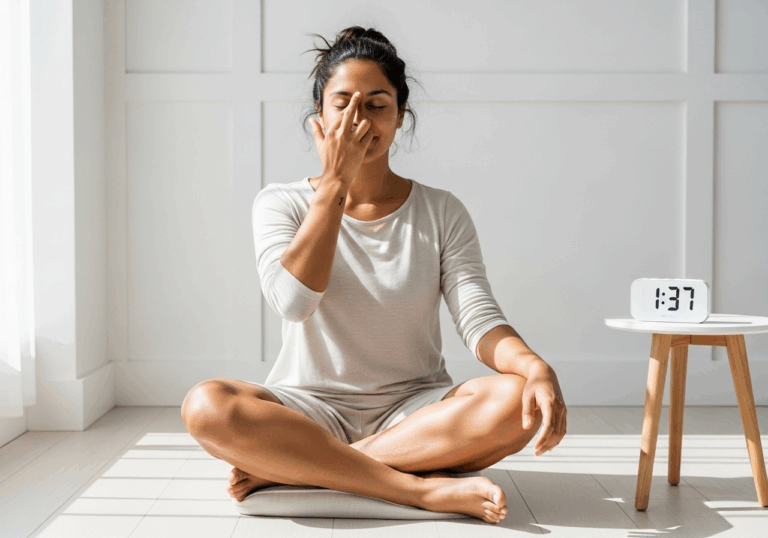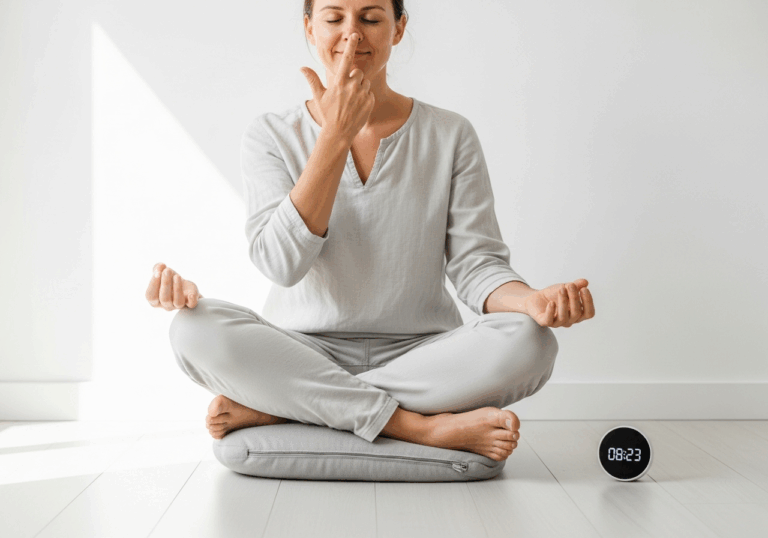Science-Backed Tips
Enhance Mood with Breathwork Techniques
ANB shows 10-15% reduction in alpha/mu oscillations.
📊 Did you know?
💡 Why It Matters
1️⃣
Breathwork techniques like ANB can significantly enhance mood and focus.
2️⃣
Reduced alpha/mu oscillations may lead to improved mental clarity and reduced anxiety.
3️⃣
Increased theta connectivity is associated with better emotional regulation.
✅ Try These Micro-Tips
🎯
Practice alternating nostril breathing for 10 minutes daily.
🎯
Engage in focused breathwork sessions 3 times a week.
🎯
Combine breathwork with mindfulness meditation for enhanced effects.
🎯
Track your mood before and after breathwork sessions to measure impact.
📚 The study
The research involved naive adults who underwent EEG monitoring while practicing different breathing techniques.
The findings revealed that ANB led to a significant suppression of alpha/mu oscillations, approximately 10-15%, which is associated with enhanced mental clarity and reduced anxiety.
Additionally, there was an increase in frontal theta connectivity, indicating improved emotional regulation and focused calmness.
Interestingly, heart rate (HR) and heart rate variability (HRV) remained unchanged, suggesting that the benefits of ANB are more about neural modulation than physiological stress responses.
This study highlights the importance of breathwork techniques like ANB in enhancing mood and focus, making it a valuable tool for those seeking to improve their mental well-being.
By integrating these practices into daily routines, individuals can experience a greater awareness of their mood states and cultivate a more centered and calm mindset.
❓ Frequently Asked Questions ❓
Learn more
What is ANB?
ANB stands for Alternate Nostril Breathing, a breathwork technique that involves inhaling and exhaling through alternate nostrils. It is believed to enhance mood and focus while promoting relaxation.
How does ANB affect brain activity?
High-density EEG studies show that ANB suppresses alpha/mu oscillations by approximately 10–15% and increases theta connectivity. This indicates reduced arousal and enhanced mood-focused attention.
What are alpha/mu oscillations?
Alpha/mu oscillations are brainwave patterns associated with relaxed, calm states and are often linked to mental clarity. Suppressing these oscillations can lead to improved focus and reduced anxiety.
What is theta connectivity?
Theta connectivity refers to the synchronization of brain activity in the theta frequency range, which is associated with emotional regulation and focused attention. Increased theta connectivity during ANB suggests enhanced emotional awareness.
How long should I practice ANB for optimal benefits?
It is recommended to practice alternating nostril breathing for at least 10 minutes daily. Engaging in focused breathwork sessions three times a week can further enhance its effects.
Can ANB improve my mood?
Yes, ANB can significantly enhance mood by promoting relaxation and reducing anxiety. The suppression of alpha/mu oscillations during the practice indicates improved mood-state awareness.
Is there a connection between breathwork and mindfulness?
Yes, combining breathwork techniques like ANB with mindfulness meditation can lead to enhanced mental clarity and emotional regulation. This combination can amplify the benefits of both practices.
How can I measure the impact of ANB on my mood?
You can track your mood before and after breathwork sessions to assess the impact of ANB on your emotional state. Keeping a journal can help you identify patterns and improvements over time.
What are the physiological effects of ANB?
During ANB, heart rate (HR) and heart rate variability (HRV) remain unchanged, indicating that the practice primarily affects neural modulation rather than physiological stress responses. This suggests a focused calm state rather than a heightened arousal state.
Who can benefit from practicing ANB?
Naive adults and individuals seeking to improve their mood and focus can benefit from practicing ANB. It is a simple technique that can be easily incorporated into daily routines for enhanced well-being.





